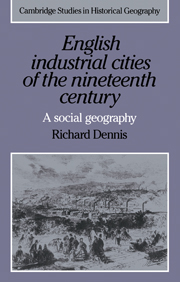Book contents
- Frontmatter
- Contents
- List of Figures
- List of Tables
- Preface
- A note on prices and distances
- 1 Urban geography and social history
- 2 Sources of diversity among Victorian cities
- 3 Contemporary accounts of nineteenth-century cities
- 4 Public transport and the journey to work
- 5 The geography of housing
- 6 Class consciousness and social stratification
- 7 The spatial structure of nineteenth-century cities
- 8 Residential mobility, persistence and community
- 9 Community and interaction
- 10 The containing context
- Notes
- Bibliography
- Index
2 - Sources of diversity among Victorian cities
Published online by Cambridge University Press: 05 January 2010
- Frontmatter
- Contents
- List of Figures
- List of Tables
- Preface
- A note on prices and distances
- 1 Urban geography and social history
- 2 Sources of diversity among Victorian cities
- 3 Contemporary accounts of nineteenth-century cities
- 4 Public transport and the journey to work
- 5 The geography of housing
- 6 Class consciousness and social stratification
- 7 The spatial structure of nineteenth-century cities
- 8 Residential mobility, persistence and community
- 9 Community and interaction
- 10 The containing context
- Notes
- Bibliography
- Index
Summary
Nineteenth-century perspectives
‘What is true of London, is true of Manchester, Birmingham, Leeds, is true of all great towns.’ So Engels wrote at the beginning of his famous chapter on ‘The Great Towns’ in The condition of the working class in England; but what was ‘true’ was so generalised as to be of little value to us in deciding on the similarity of nineteenth-century cities: ‘Everywhere barbarous indifference, hard egotism on one hand, and nameless misery on the other, everywhere social warfare, every man's house in a state of siege, everywhere reciprocal plundering under the protection of the law …’
Nearly thirty years later, Engels was more specific about at least one common process, the clearance of centrally located workers' houses and their replacement by high-rent shops, warehouses and public buildings that reflected the high value ascribed to central land. The universal consequence was the expulsion of workers to the suburbs and the raising of house rents. This ‘spirit of Haussmann’ was characteristic of Paris, Berlin, Vienna, London, Manchester and Liverpool. But elsewhere in The housing question, Engels was at pains to distinguish the European capitals from smaller provincial cities: ‘In towns which grew up from the very beginning as industrial centres this housing shortage is as good as unknown; for instance, Manchester, Leeds, Bradford, Barmen-Elberfeld. On the other hand, in London, Paris, Berlin, Vienna, the shortage took an acute form at the time [of rural-urban migration], and has, for the most part, continued to exist in a chronic form.’
- Type
- Chapter
- Information
- English Industrial Cities of the Nineteenth CenturyA Social Geography, pp. 15 - 47Publisher: Cambridge University PressPrint publication year: 1984
- 1
- Cited by

